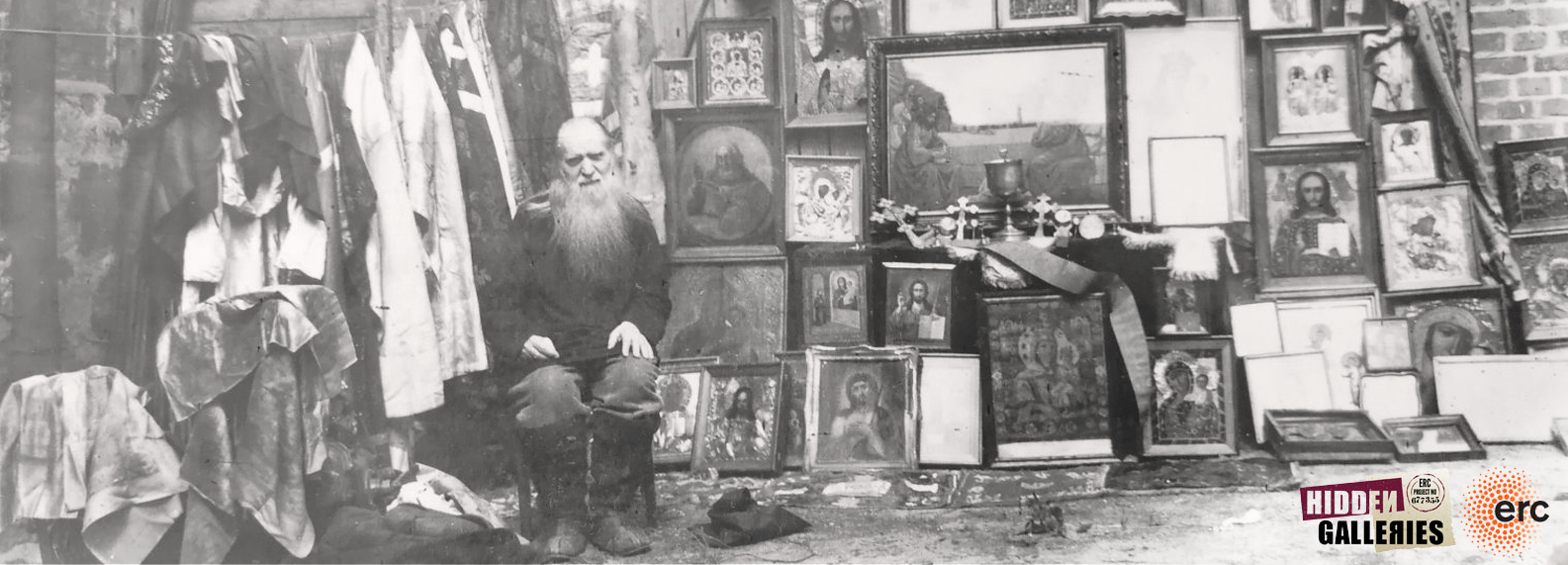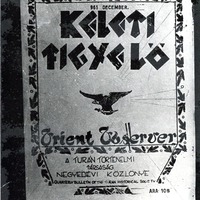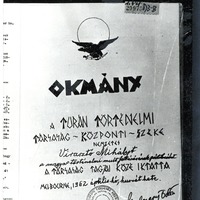Intercepted materials from Church of Turan Believers of One God Hungary
Item
Title
Intercepted materials from Church of Turan Believers of One God Hungary
A Turáni Egyistenhívők egyházától elkobzott dokumentumok
Description
These images have been selected from the photo-documentation of materials sent by post to Mihály Virasztó, a former religious specialist of the Church of the Turan Believers of One God. The first photo shows the cover page of the Keleti Figyelő [Orient Observer], the short-lived journal of the Turáni Történelmi Társaság [Turan Historical Society] founded by immigrant Hungarians in Melbourne, Australia. The second photo shows a certificate of honorary membership of Mihály Virasztó for supporting the study of Hungarian history, issued by the same society in 1962. The images come from a documentary file on Virasztó.
The case of the Orient Observer is illustrative of the performative power of certain objects and of the responsive mechanisms of the secret police. By the time of the journal’s arrival in February 1962, Mihály Virasztó had been under surveillance for years, after being classified as dangerous due to his openly anti-communist stance, involvement in 1956, relations with right-wing emigrants, and his past as the priest and activist of the Turan Believers of One God. The arrival of the issues and the certificate was reported by an informant working on Virasztó in July 1962, only four months after the local county division of the secret police had claimed in a report that the Church of the Turan Believers of One God was practically non-existent in the region. Along with Virasztó’s correspondence with other Hungarian right wing emigrants and his involvement in a case of anonymous anti-collectivization letters, the package set the machinery of the secret police in motion. The local branch of the secret police made excessive efforts to get hold of the issues: they asked for photocopies from the Budapest headquarters, while also drawing up a plan to get Virasztó’s own copies. The police also mobilized its network of informants to find out if Virasztó was disseminating the issues, and instructed them to collect more information on the Turan Believers of One God as well. In September 1962, the Budapest headquater sent the copies of the certificate and selected pages of the journal, with a short note that according to their examinations, the articles focused on "the origins and development of various languages”. To decide whether the journal’s content was "hostile”, the local secret police attained Virasztó’s copies in March 1963 through a local informant, who managed to borrow them from him for a couple of days. The Orient Observer was also featured in Virasztó’s two penal files from 1964 and 1966. From these and from other informant reports we know that he had given the issues to several people, the director of the local museum being among them. We also learn from these files that during a house search at his home in 1964 the secret police was looking for the issues but could not find them. The Observer came to the forefront again in 1966, at the time of Virasztó’s last penal case, with the secret police planning a complex operation for its confiscation. This time their aim was to produce evidence that Virasztó was circulating materials hostile to the regime.
The Orient Observer was founded in 1960 and had only two volumes and four numbers during its existence. Printed on a small offset printing machine and having hand-drawn illustrations, it claimed to be scientific and focused mainly on the origins of the Hungarian people. Using linguistic and historical argumentation that would not stand up to modern academic scrutiny, the journal argued for the relatedness of Hungarians to various past and present Asiatic peoples. Although the articles were not openly political, the issues contained some negative references to communism and the Soviet Union here and there. One of these, a sentence on the fatal consequences of Soviet dominance for the future of the Hungarian nation, was picked out by the secret police as proof of Virasztó possessing and circulating anti-communist contents.
Mihály Virasztó had a long police record in both regimes before and after 1945. As a priest (táltos) and missionary of the Church of the Turan Believers of One God he was repeatedly condemned to prison at the end of the 1930’s for "agitation against religious denominations”. He remained on the radar of authorities in the communist regime for his anti-communist political views and activity, his relationships with right-wing figures abroad, and also for his past and supposedly present involvement with the Church of Turan Believers of One God. He had several clashes with the authorities: he was imprisoned for two month in 1952 for slander, detained for possessions of arms in 1957, a charge that was later dropped, his mental health was investigated and he was sent to a mental hospital in 1964 and 1967. After his last release in the summer of 1968, he was placed under the guardianship of his wife. His file was closed in 1972.
These images come from file ÁBTL 3.1.5 O-14980/18. The file also includes confiscated personal letters and photographs, two poems written by Virasztó, lists of confiscated items, medical reports, interrogation minutes, and informant reports.
For further entries on Virasztó and the Church of Turan Believers of One God see:
The case of the Orient Observer is illustrative of the performative power of certain objects and of the responsive mechanisms of the secret police. By the time of the journal’s arrival in February 1962, Mihály Virasztó had been under surveillance for years, after being classified as dangerous due to his openly anti-communist stance, involvement in 1956, relations with right-wing emigrants, and his past as the priest and activist of the Turan Believers of One God. The arrival of the issues and the certificate was reported by an informant working on Virasztó in July 1962, only four months after the local county division of the secret police had claimed in a report that the Church of the Turan Believers of One God was practically non-existent in the region. Along with Virasztó’s correspondence with other Hungarian right wing emigrants and his involvement in a case of anonymous anti-collectivization letters, the package set the machinery of the secret police in motion. The local branch of the secret police made excessive efforts to get hold of the issues: they asked for photocopies from the Budapest headquarters, while also drawing up a plan to get Virasztó’s own copies. The police also mobilized its network of informants to find out if Virasztó was disseminating the issues, and instructed them to collect more information on the Turan Believers of One God as well. In September 1962, the Budapest headquater sent the copies of the certificate and selected pages of the journal, with a short note that according to their examinations, the articles focused on "the origins and development of various languages”. To decide whether the journal’s content was "hostile”, the local secret police attained Virasztó’s copies in March 1963 through a local informant, who managed to borrow them from him for a couple of days. The Orient Observer was also featured in Virasztó’s two penal files from 1964 and 1966. From these and from other informant reports we know that he had given the issues to several people, the director of the local museum being among them. We also learn from these files that during a house search at his home in 1964 the secret police was looking for the issues but could not find them. The Observer came to the forefront again in 1966, at the time of Virasztó’s last penal case, with the secret police planning a complex operation for its confiscation. This time their aim was to produce evidence that Virasztó was circulating materials hostile to the regime.
The Orient Observer was founded in 1960 and had only two volumes and four numbers during its existence. Printed on a small offset printing machine and having hand-drawn illustrations, it claimed to be scientific and focused mainly on the origins of the Hungarian people. Using linguistic and historical argumentation that would not stand up to modern academic scrutiny, the journal argued for the relatedness of Hungarians to various past and present Asiatic peoples. Although the articles were not openly political, the issues contained some negative references to communism and the Soviet Union here and there. One of these, a sentence on the fatal consequences of Soviet dominance for the future of the Hungarian nation, was picked out by the secret police as proof of Virasztó possessing and circulating anti-communist contents.
Mihály Virasztó had a long police record in both regimes before and after 1945. As a priest (táltos) and missionary of the Church of the Turan Believers of One God he was repeatedly condemned to prison at the end of the 1930’s for "agitation against religious denominations”. He remained on the radar of authorities in the communist regime for his anti-communist political views and activity, his relationships with right-wing figures abroad, and also for his past and supposedly present involvement with the Church of Turan Believers of One God. He had several clashes with the authorities: he was imprisoned for two month in 1952 for slander, detained for possessions of arms in 1957, a charge that was later dropped, his mental health was investigated and he was sent to a mental hospital in 1964 and 1967. After his last release in the summer of 1968, he was placed under the guardianship of his wife. His file was closed in 1972.
These images come from file ÁBTL 3.1.5 O-14980/18. The file also includes confiscated personal letters and photographs, two poems written by Virasztó, lists of confiscated items, medical reports, interrogation minutes, and informant reports.
For further entries on Virasztó and the Church of Turan Believers of One God see:
For further readings see:
Ablonczy Balázs 2016 Keletre Magyar! A magyar turanizmus története. Budapest, Jaffa Kiadó.
Fazekas Csaba 1996 Kisegyházak és szektakérdés a Horthy-korszakban. Budapest, TEDISZ–SzPA.
Szécsényi Mihály 2013 Virrasztó Koppány és társai. A Turáni Egyistenhívők és a hatalom az 1930-as évek második felében. In Lukács Anikó (szerk.): Rendi társadalom – polgári társadalom 25. Budapest, Hajnal István Kör, 349–362.
A képek a Turáni Egyistenhívők Egyháza egykori tagjának és vallási specialistájának, Virasztó Mihálynak küldött dokumentumokról készült fotósorozat tagjai. Az első fotón a magyar emigránsok által Melbourne-ben alapított Turáni Történelmi Társaság rövid életű folyóiratának, a Keleti Figyelőnek a borítója látható; a másodikon képen Virasztó tagfelvételi „Okmánya” ugyanebbe a szerveztebe, amelyet „a magyar múlt feltárásának pártolásáért” érdemelt ki 1962-ben. Mindkét kép eredetileg Virasztó dossziéjából származik.
A Keleti Figyelő esete kiválóan illusztrálja a titkosszolgálatok működését. A folyóirat 1962-es felbukkanása előtt a titkosrendőrség már évek óta veszélyes elemként kezelte és figyelte Virasztót, nyíltan anti-kommunista megnyilvánulásai, 1956-os tevékenysége, szélsőjobboldali magyar emigránsokkal folytatott levelezése, és a Turáni Egyistenhívők Egyházában betöltött korábbi szerepe miatt. A folyóirat és az okmány érkezését elsőként egy Virasztóra állított ügynök jelezte 1962 júliusában, mindössze négy hónappal azután, hogy az állambiztonság helyi kirendeltségének egyik jelentése szerint Virasztó lakóhelyén „az említett szekta nem él”. A folyóirat érkezése azonban mozgásba hozta a titkosrendőrség gépezetét – feltehetően amiatt is, hogy Virasztó ekkortájt gyanúba keveredett egy névtelen téeszesítés ellenes levelekkel kapcsolatos ügyben is. A rendőrség helyi kirendeltsége minden követ megmozgatott, hogy megszerezze a folyóiratot: fotómásolatot kértek a központtól, operatív tervet dolgoztak ki Virasztó saját példányának megszerzésére, helyi ügynökeiket pedig utasították arra, hogy további információkat szerezzenek a Turáni Egyistenhívőkről. A budapesti központ 1962 szeptemberében küldött másolatokat az okmányról és a folyóirat egyes oldalairól azzal a rövid megjegyzéssel, hogy elemzésük szerint a folyóirat elsősorban „a különböző nyelvek eredetével és azok fejlődésével foglalkozik”. A titkosrendőrség helyi kirendeltsége ennek ellenére igyekezett megszerezni Virasztó saját példányát is, hogy biztonsággal eldönthesse, ellenséges kiadványról van-e szó: ez végül 1963 márciusában sikerült, amikor az egyik helyi ügynök pár napra kölcsönkapta a nyomtatványt Virasztótól. A Keleti Figyelőt Virasztó két, 1964-es és 1966-os vizsgálati dossziéja is említi. Ezekből és egyéb ügynöki jelentésekből tudjuk, hogy a folyóirat számait Virasztó többeknek, például a helyi múzeum igazgatójának is kölcsönadta, és hogy az 1964-es házkutatás során a titkosrendőrség kereste, de nem találta a példányokat. A folyóirat 1966-ban, Virasztó utolsó perében is előtérbe került, amikor is a rendőrség bonyolult operatív tervet dolgozott ki a megszerzésére, mert ezzel kívánták bizonyítani, hogy Virasztó rendszerellenes kiadványokat terjeszt.
A Keleti Figyelőt 1960-ban alapították, és mindösszesen két évfolyama és négy száma jelent meg. A magát tudományosnak tekintő folyóirat házi körülmények között készült egy kis offset nyomdagépen, kézzel rajzolt illusztrációkkal, célja pedig a magyarok eredetének feltárása volt: a ma már tudományosan nem helytálló nyelvészeti és történeti érvrendszert felvonultató tanulmányok a magyarok és különböző, egykori és jelenkori ázsiai népek rokonságát igyekeztek bizonyítani. Habár az írások nyílt politikai állásfoglalást nem tartalmaztak, a Szovjetunióról több ízben is negatív értelemben írtak. Az egyik ilyen mondatot, amely a szovjet „gyarmatosítás” magyar nemzetre nézve végzetes voltáról szólt, a titkosrendőrség is kiemelte mint annak bizonyítékát, hogy Virasztó rendszerellenes kiadványt birtokol és terjeszt.
Virasztó már 1945 előtt is sorozatosan összetűzésbe került a hatóságokkal. A Turáni Egyistenhívők Egyházának táltosaként és hittérítőjeként az 1930-as évek végén többször is ült börtönben „hitfelkezetek elleni izgatás” miatt. Múltja, anti-kommunista nézetei és tevékenysége, szélsőjobboldali emigránsokkal való kapcsolata és a Turáni Egyistenhívő csoportjában 1945 utáni feltételezett aktivitása miatt a kommunista titkosrendőrség is megfigyelte és fellépett ellene: 1957-es letartóztatása előtt 1952-ben rágalmazásért két hónapot ült, 1964-ben és 1967-ben pedig elmeorvosi vizsgálat után kényszergyógykezelték. 1968-as szabadulása után a felesége gyámhatósága alá helyezték, aktáját 1972-ben zárták le.
A képek az ÁBTL 3.1.5 O-14980/18 dossziéban találhatók, amely ezen kívül elkobzott személyes leveleket és fényképeket, Virasztó Mihály két versét, orvosi jelentéseket, kihallgatási jegyzőkönyveket és ügynöki jelentéseket tartalmaz.
A Keleti Figyelő esete kiválóan illusztrálja a titkosszolgálatok működését. A folyóirat 1962-es felbukkanása előtt a titkosrendőrség már évek óta veszélyes elemként kezelte és figyelte Virasztót, nyíltan anti-kommunista megnyilvánulásai, 1956-os tevékenysége, szélsőjobboldali magyar emigránsokkal folytatott levelezése, és a Turáni Egyistenhívők Egyházában betöltött korábbi szerepe miatt. A folyóirat és az okmány érkezését elsőként egy Virasztóra állított ügynök jelezte 1962 júliusában, mindössze négy hónappal azután, hogy az állambiztonság helyi kirendeltségének egyik jelentése szerint Virasztó lakóhelyén „az említett szekta nem él”. A folyóirat érkezése azonban mozgásba hozta a titkosrendőrség gépezetét – feltehetően amiatt is, hogy Virasztó ekkortájt gyanúba keveredett egy névtelen téeszesítés ellenes levelekkel kapcsolatos ügyben is. A rendőrség helyi kirendeltsége minden követ megmozgatott, hogy megszerezze a folyóiratot: fotómásolatot kértek a központtól, operatív tervet dolgoztak ki Virasztó saját példányának megszerzésére, helyi ügynökeiket pedig utasították arra, hogy további információkat szerezzenek a Turáni Egyistenhívőkről. A budapesti központ 1962 szeptemberében küldött másolatokat az okmányról és a folyóirat egyes oldalairól azzal a rövid megjegyzéssel, hogy elemzésük szerint a folyóirat elsősorban „a különböző nyelvek eredetével és azok fejlődésével foglalkozik”. A titkosrendőrség helyi kirendeltsége ennek ellenére igyekezett megszerezni Virasztó saját példányát is, hogy biztonsággal eldönthesse, ellenséges kiadványról van-e szó: ez végül 1963 márciusában sikerült, amikor az egyik helyi ügynök pár napra kölcsönkapta a nyomtatványt Virasztótól. A Keleti Figyelőt Virasztó két, 1964-es és 1966-os vizsgálati dossziéja is említi. Ezekből és egyéb ügynöki jelentésekből tudjuk, hogy a folyóirat számait Virasztó többeknek, például a helyi múzeum igazgatójának is kölcsönadta, és hogy az 1964-es házkutatás során a titkosrendőrség kereste, de nem találta a példányokat. A folyóirat 1966-ban, Virasztó utolsó perében is előtérbe került, amikor is a rendőrség bonyolult operatív tervet dolgozott ki a megszerzésére, mert ezzel kívánták bizonyítani, hogy Virasztó rendszerellenes kiadványokat terjeszt.
A Keleti Figyelőt 1960-ban alapították, és mindösszesen két évfolyama és négy száma jelent meg. A magát tudományosnak tekintő folyóirat házi körülmények között készült egy kis offset nyomdagépen, kézzel rajzolt illusztrációkkal, célja pedig a magyarok eredetének feltárása volt: a ma már tudományosan nem helytálló nyelvészeti és történeti érvrendszert felvonultató tanulmányok a magyarok és különböző, egykori és jelenkori ázsiai népek rokonságát igyekeztek bizonyítani. Habár az írások nyílt politikai állásfoglalást nem tartalmaztak, a Szovjetunióról több ízben is negatív értelemben írtak. Az egyik ilyen mondatot, amely a szovjet „gyarmatosítás” magyar nemzetre nézve végzetes voltáról szólt, a titkosrendőrség is kiemelte mint annak bizonyítékát, hogy Virasztó rendszerellenes kiadványt birtokol és terjeszt.
Virasztó már 1945 előtt is sorozatosan összetűzésbe került a hatóságokkal. A Turáni Egyistenhívők Egyházának táltosaként és hittérítőjeként az 1930-as évek végén többször is ült börtönben „hitfelkezetek elleni izgatás” miatt. Múltja, anti-kommunista nézetei és tevékenysége, szélsőjobboldali emigránsokkal való kapcsolata és a Turáni Egyistenhívő csoportjában 1945 utáni feltételezett aktivitása miatt a kommunista titkosrendőrség is megfigyelte és fellépett ellene: 1957-es letartóztatása előtt 1952-ben rágalmazásért két hónapot ült, 1964-ben és 1967-ben pedig elmeorvosi vizsgálat után kényszergyógykezelték. 1968-as szabadulása után a felesége gyámhatósága alá helyezték, aktáját 1972-ben zárták le.
A képek az ÁBTL 3.1.5 O-14980/18 dossziéban találhatók, amely ezen kívül elkobzott személyes leveleket és fényképeket, Virasztó Mihály két versét, orvosi jelentéseket, kihallgatási jegyzőkönyveket és ügynöki jelentéseket tartalmaz.
Virasztóról és a Turáni Egyistenhívők Egyházáról bővebben lásd:
Ablonczy Balázs 2016 Keletre Magyar! A magyar turanizmus története. Budapest, Jaffa Kiadó.
Fazekas Csaba 1996 Kisegyházak és szektakérdés a Horthy-korszakban. Budapest, TEDISZ–SzPA.
Szécsényi Mihály 2013 Virrasztó Koppány és társai. A Turáni Egyistenhívők és a hatalom az 1930-as évek második felében. In Lukács Anikó (szerk.): Rendi társadalom – polgári társadalom 25. Budapest, Hajnal István Kör, 349–362.
Ablonczy Balázs 2016 Keletre Magyar! A magyar turanizmus története. Budapest, Jaffa Kiadó.
Fazekas Csaba 1996 Kisegyházak és szektakérdés a Horthy-korszakban. Budapest, TEDISZ–SzPA.
Szécsényi Mihály 2013 Virrasztó Koppány és társai. A Turáni Egyistenhívők és a hatalom az 1930-as évek második felében. In Lukács Anikó (szerk.): Rendi társadalom – polgári társadalom 25. Budapest, Hajnal István Kör, 349–362.
Subject
Communism and religion
Communism--Europe--History--20th century
Communism--Europe, Eastern--History--20th century
Secret police (secret service)
Surveillance
Totalitarianism
Religion and politics--Europe
Religion and state--Europe
Religious groups
Religious sects
Communism--Hungary--History
Confiscations
Hungary. Államvédelmi Hatóság
Nationalism and communism
Nationalism and socialism
Creator
Agnes Hesz
Source
Állambiztonsági Szolgálatok Történeti Levéltára
ÁBTL 3.1.5 O-14980/18
ÁBTL 3.1.5 O-14980/18
Publisher
This project has received funding from the European Research Council (ERC) under the European Union’s Horizon 2020 research and innovation programme No . 677355
Date
1962–1966
Rights
copyright for these images belongs to ÁBTL
Format
image/tif
Language
HU
Type
image
Identifier
ÁBTL 3.1.5 O-14980/18
Coverage
Hungary
Bibliographic Citation
Agnes Hesz, "Intercepted materials from Church of Turan Believers of One God Hungary,"
Date Created
2018


